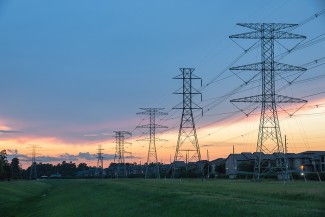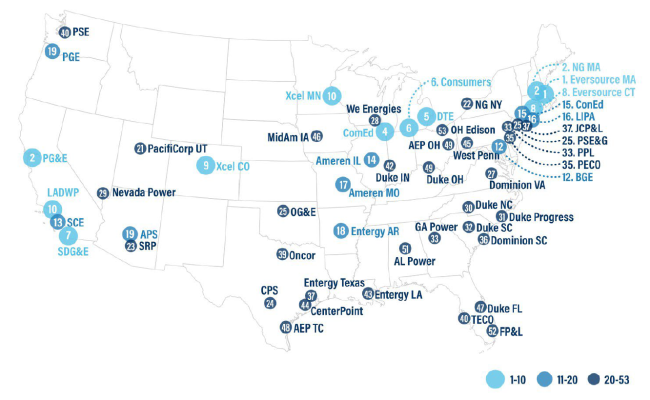Energy savings from electric utilities’ efficiency programs for customers have stagnated in recent years, according to the Utility Energy Efficiency Scorecard released today by the American Council for an Energy-Efficient Economy (ACEEE). The Scorecard evaluates 53 of the largest U.S. electric utilities on their incentive and other programs for energy-saving improvements and finds that energy savings dropped 5.4% between 2018 and 2021. The Scorecard includes a large-scale assessment of utility performance on energy equity, finding major gaps in bringing energy savings to underserved households.
Utility programs are the primary drivers of energy savings in most states, and leading utilities can serve as models. Eversource Massachusetts topped the Scorecard for the third consecutive time. Rounding out the top five utilities are Pacific Gas & Electric in California (tied for #2), National Grid Massachusetts (tied for #2), Commonwealth Edison in Illinois (#4), and DTE in Michigan (#5). Overall, the report finds a wide range of performance, but only 15 of the utilities earn at least half of the Scorecard’s points. The report also finds many opportunities for improvement, even among the leaders.
“Amid ever-higher temperatures and increasingly common extreme weather, most utilities, regulators, and state policymakers should do a lot more to help reduce energy waste,” said Mike Specian, utilities manager at ACEEE and lead author of the Scorecard. “Now is the time for bold action by all utilities and states to scale up energy efficiency efforts rapidly. What they’re doing today is not enough.”
Most utilities that score well are in states that have enacted robust energy savings targets and provide strong regulatory support for achieving those targets. Virginia illustrates the importance of a robust policy framework for successful efficiency programs. Dominion Virginia moved to 27th place, up from 50th place in the 2020 Scorecard, largely due to a 2020 law requiring electric utilities to establish efficiency programs that achieve specific energy-saving targets. In Michigan, the legislature is considering a proposal to increase utility energy-saving targets to 2% of annual sales starting in 2025, which could vault the state’s energy companies past the perennial leaders in Massachusetts and California.
2023 Utility Energy Efficiency Scorecard rankings
Most utilities have significant room for improvement on equity in efficiency programs
As part of its expanded focus on equity, the Scorecard includes metrics that were developed as part of a multiyear consultation process with community-based organizations. Eversource Massachusetts and Pacific Gas & Electric stand out for earning 84% of the equity points available, but more than three-quarters of the utilities scored less than half the equity points available.
“Low-income communities and communities of color often face significant barriers preventing them from participating in utility efficiency programs. Centering equity in energy efficiency means not just providing efficiency incentives to underserved communities but also working with them to design programs that best serve them,” Specian said.
The Scorecard looks at how utilities handle customers at risk of having their electric service disconnected, which can severely damage people’s health and well-being by depriving them of safe living temperatures, refrigeration, and the use of medical equipment. Only 13 of the utilities direct customers at risk of service disconnection toward energy efficiency programs, which can reduce utility bills and make shutoffs less likely. This is particularly important because utilities disconnected service to more than four million customers last year.
Because energy efficiency supports more than 2.2 million American jobs, the Scorecard evaluates utilities on how they ensure diverse workforces for their efficiency programs. Over half—28 utilities—achieve none of the Scorecard’s workforce diversity measures. Twenty-one earn some workforce points, with the majority of that group having only diversity requirements for suppliers or contractors. Only four utilities score full points for their workforce efforts, including Consolidated Edison in New York. Among its leading workforce policies are publishing employee demographics annually; using diversity, equity, and inclusion goals to guide decision-making; and linking executive compensation to meeting those goals.
Only two utilities—Eversource Massachusetts and National Grid Massachusetts—score full points for reaching customers who do not speak English. Those utilities have language access plans that track program participation and energy savings by customers whose primary language is not English, and the utilities have educational materials on their efficiency programs in 13 languages. Almost 80% of utilities scored receive no credit for language access.
Lowest-performing utilities have little to no energy savings
The five lowest-scoring utilities are Ohio Edison (#53), Florida Power and Light (#52), Alabama Power (#51), Duke Ohio (#50), and American Electric Power Ohio (#49). Ohio utilities score poorly because of a 2019 law that eliminated utility efficiency programs in the state. Nearly all of the 5% drop in energy savings nationally in recent years can be attributed to the elimination of Ohio’s efficiency programs.
The 2023 Utility Scorecard evaluates the 50 largest electric utilities in the country by retail sales volume as well as three other utilities that were assessed in previous editions of the Scorecard. The 53 utilities in this year’s Scorecard serve around 79 million residential customers, or about 60% of all U.S. households. ACEEE previously published Utility Scorecards in 2017 and 2020.
NOTE: The Scorecard and press release have been updated to reflect that PG&E and National Grid Massachusetts tied for second place. Due to a miscommunication in verifying data, we originally stated that PG&E ranked second and National Grid Massachusetts ranked third.



